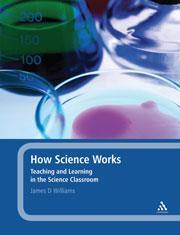Kay Stephenson reviews this guide to teahcing and learning in the science classroom
How science works: teaching and learning in the science classroom
James Williams
London: Continuum 2011 | Pp168 | £19.99 (PB) | ISBN9781441147073
Reviewed by Kay Stephenson

Although there are already quite a number of texts covering How Science Works, James Williams has written a short but comprehensive book that provides a useful addition to the collection. The opening chapter focuses on the importance of understanding the idea of ‘the nature of science’ which, very effectively, provides the framework for the remainder of the book.
Williams explores the strategy of teaching science through a How Science Works approach and provides clarification and justification for each aspect covered. Each chapter offers short, succinct and often thought-provoking discussions. The background information is relevant and interesting. Helpful suggestions for individual or group, reflective and classroom tasks are incorporated into most chapters along with references to books, journals, articles and weblinks for further reading.
Initially intending to dip in and out of the book, (a tactic Williams suggests in his introduction) I found myself drawn to reading the book from cover to cover. I found something in each chapter that made me pause for thought but particularly appreciated the sections covering scientific terminology, communicating science, the nature of scientific versus unscientific questions and investigation and experimentation in science. This latter section expands the author’s honest appraisal of how closely (or not) school science resembles real science and throughout the book Williams provides numerous insights into what school science is and what it is not.
There are a few niggling errors in places which made me need to re-read some paragraphs but these are very minor quibbles given the engaging and perceptive nature of the content. Both trainee and experienced teachers would benefit from delving into this book as well as those responsible for curriculum and scheme of work development.
Related Links
How science works: teaching and learning in the science classroom
Purchase this book from Amazon.co.uk






No comments yet